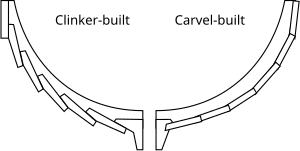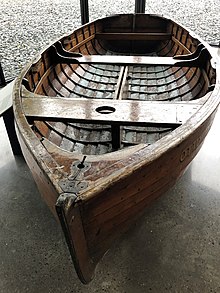
Longships were a type of specialised Scandinavian warships that have a long history in Scandinavia, with their existence being archaeologically proven and documented from at least the fourth century BC. Originally invented and used by the Norsemen for commerce, exploration, and warfare during the Viking Age, many of the longship's characteristics were adopted by other cultures, like Anglo-Saxons, and continued to influence shipbuilding for centuries.
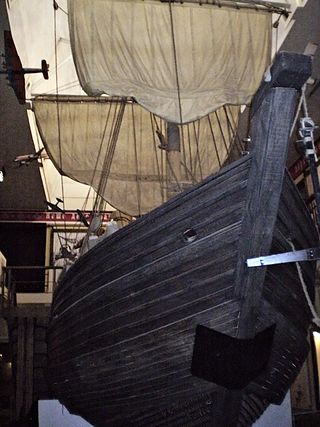
The koch was a special type of small one- or two-mast wooden sailing ships designed and used in Russia for transpolar voyages in ice conditions of the Arctic seas, popular among the Pomors.

A cog was a type of ship that was used during the Middle Ages, mostly for trade and transport but also in war. It first appeared in the 10th century, and was widely used from around the 12th century on. Cogs were clinker-built, generally of oak. Cogs were fitted with a single mast and a single square sail. They were used primarily for trade in north-west medieval Europe, especially by the Hanseatic League. Typical seagoing cogs were from 15 to 25 meters long, 5 to 8 meters wide, and were of 30–200 tons burthen. Cogs were rarely as large as 300 tons although a few were considerably larger, over 1,000 tons.

Carvel built or carvel planking is a method of boat building in which hull planks are laid edge to edge and fastened to a robust frame, thereby forming a smooth surface. Traditionally the planks are neither attached to, nor slotted into, each other, having only a caulking sealant between the planks to keep water out. Modern carvel builders may attach the planks to each other with glues and fixings. It is a "frame first" method of hull construction, where the shape is determined by the framework onto which the planks are fixed. This is in contrast to "plank first" or "shell first" methods, where the outer skin of the hull is made and then reinforced by the insertion of timbers that are fitted to that shape. The most common modern "plank first" method is clinker construction; in the classical period "plank first" involved joining the edges of planks with mortise and tenon joints within the thickness of the timbers, superficially giving the smooth-hull appearance of carvel construction, but achieved by entirely different means.

Boat building is the design and construction of boats and their systems. This includes at a minimum a hull, with propulsion, mechanical, navigation, safety and other systems as a craft requires.

The Gokstad ship is a 9th-century Viking ship found in a burial mound at Gokstad in Sandar, Sandefjord, Vestfold, Norway. It is displayed at the Viking Ship Museum in Oslo, Norway. It is the largest preserved Viking ship in Norway.

On a vessel's hull, a strake is a longitudinal course of planking or plating which runs from the boat's stempost to the sternpost or transom. The garboard strakes are the two immediately adjacent to the keel on each side.
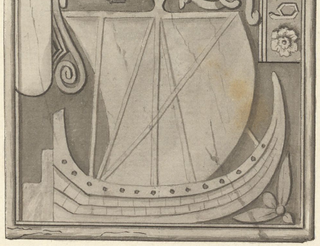
The birlinn or West Highland galley was a wooden vessel propelled by sail and oar, used extensively in the Hebrides and West Highlands of Scotland from the Middle Ages on. Variants of the name in English and Lowland Scots include "berlin" and "birling". The Gaelic term may derive from the Norse byrðingr, a type of cargo vessel. It has been suggested that a local design lineage might also be traceable to vessels similar to the Broighter-type boat, equipped with oars and a square sail, without the need to assume a specific Viking design influence. It is uncertain, however, whether the Broighter model represents a wooden vessel or a skin-covered boat of the currach type. The majority of scholars emphasise the Viking influence on the birlinn.

The Hjortspring boat is a vessel designed as a large canoe, from the Scandinavian Pre-Roman Iron Age. It was built circa 400–300 BC. The hull and remains were rediscovered and excavated in 1921–1922 from the bog of Hjortspring Mose on the island of Als in Sønderjylland, southern Denmark. The boat is the oldest find of a wooden plank ship in Scandinavia and it closely resembles the thousands of petroglyph images of Nordic Bronze Age ships found throughout Scandinavia. The vessel is a clinker-built wooden boat of more than 19 metres length overall, 13.6 metres long inside, and 2 metres wide. Ten thwarts that could have served as seats, span the boat with room for two persons each; this suggests space for a crew of at least 20 who propelled the boat with paddles. The boat would have weighed an estimated 530 kilograms, making it easily portable by its crew.
The Vergulde Draeck, also spelled Vergulde Draak and Vergulde Draek, was a 41.8-metre (137 ft), 260-tonne (290-ton) ship constructed in 1653 by the Dutch East India Company.
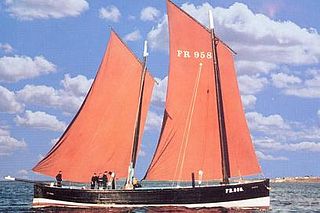
The Fifie is a design of sailing boat developed on the east coast of Scotland. It was a traditional fishing boat used by Scottish fishermen from the 1850s until well into the 20th century. These boats were mainly used to fish for herring using drift nets, and along with other designs of boat were known as herring drifters.

The Bevaix boat is a 1st-century Gallo-Roman wreck from the Bay of Bevaix, Lake Neuchatel, Switzerland. The remains of the ship, and a modern reconstruction, are on display at the Laténium archeology museum.

The Edna E. Lockwood is a Chesapeake Bay bugeye, the last working oyster boat of her kind. She is located at the Chesapeake Bay Maritime Museum in Saint Michaels, Maryland. She was built in 1889 at Tilghman Island, Maryland by John B. Harrison and is of nine-log construction, similar to the smaller log canoe, and was launched on October 5, 1889 for Daniel Haddaway, at a cost of $2,200. She worked for at least seven sets of owners from 1899 until 1967, and was then sailed as a yacht until donated to the museum in 1973. The museum undertook an extensive restoration of the Lockwood from 1975 through 1979, which restored the bugeye to its 1910 appearance with the "patent stern" that had been added sometime prior to that year. She is the last bugeye retaining the sailing rig and working appearance of the type. Her length is 53.5 feet (16.3 m), with a 15.25 feet (4.65 m) beam and a draft of 2.58 feet (0.79 m) with the centerboard up, and a maximum sail area of approximately 1700 square feet.
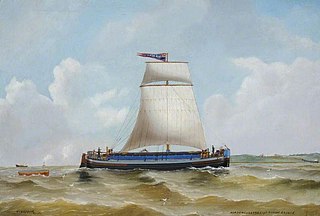
The Humber keel was a type of single-masted, square-rigged sailing craft used for inshore and inland cargo transport around Hull and the Humber Estuary, in the United Kingdom, particularly through the late 19th and early 20th centuries.
A hulk was a type of medieval ship used mostly for transports. The hulk appears to have remained a relatively minor type of sailing ship apparently peculiar to the Low Countries of Europe where it was probably used primarily as a river or canal boat, with limited potential for coastal cruising. The only evidence of hulks is from legal documents and iconography, though it is possible that a shipwreck found on the coast of Estonia in early 2022 might be the only known surviving example of a hulk.

The Sparrow-Hawk was a 'small pinnace' similar to the full-rigged pinnace Virginia that sailed for the English Colonies in June 1626. She is the earliest ship to participate in the first decades of English settlement in the New World to have survived to the present day.

Discovered by divers from the French Navy Diving School in 1967, the archaeological investigations of the Roman wreck at Madrague de Giens constituted the first large scale, "truly scientific underwater excavation[s] carried out in France". The wreck lies at around 18 to 20 metres depth off the coast of the small fishing port of La Madrague de Giens on the Giens Peninsula, east of Toulon, on the southern Mediterranean coast of France. Sunk around 75–60 BCE, the vessel has been found to be "a large merchantman of considerable tonnage—400 tons deadweight with a displacement of around 550 tons", making it one of the largest Roman wrecks excavated, with only the wreck at Albenga, Italy exceeding it at the time of its discovery. The vessel wrecked at Madrague de Giens measured around 40 metres in length; has a "wine glass" section which would have given better ability to sail to windward; displayed extended raking of the stem and stern; and had two masts. The hull was characterised by a reverse stempost in the shape of a ram with a big cutwater which "must have given... [the] craft high-performance sailing qualities". The ship sank while transporting a large cargo of wine and black glazed pottery from Italy. It is not known why it sank.

Fusi Yama was a composite barque ship of roughly 556 tons, built in 1865 by Alexander Stephen & Sons at Glasgow for Killick Martin & Company, London.

Lashed-lug boats are ancient boat-building techniques of the Austronesian peoples. It is characterized by the use of raised lugs on the inner face of hull planks. These lugs have holes drilled in them so that other hull components such as ribs, thwarts or other structural components can be tied to them with natural fiber ropes. This allows a structure to be put together without any metal fastenings. The planks are further stitched together edge-to-edge by sewing or using dowels ("treenails") unto a dugout keel and the solid carved wood pieces that form the caps for the prow and stern. Characteristically, the shell of the boat is created first, prior to being lashed unto ribs. The seams between planks are also sealed with absorbent tapa bark and fiber that expands when wet or caulked with resin-based preparations.
The Columbia boat was a type of inland boat used to carry furs, trade goods, supplies, and passengers along the Columbia River during the fur trade era, c. 1811–1845. It needed to be large enough to carry substantial cargo, light enough to portage around such obstacles as falls and rapids, and made of locally sourced materials. It was modeled after the birchbark canoe used in waterways east of the Rocky Mountains, but was sheathed with thin cedar planks.




